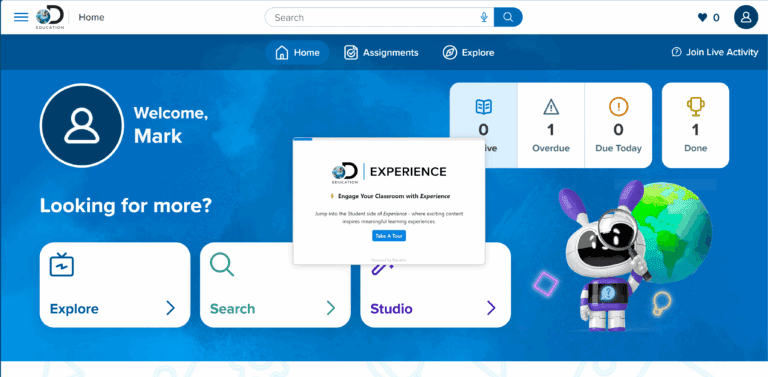Educators know that teaching reading continuously evolves as we learn about what works best. Today, many states have enacted legislation to transform reading by prioritizing well-researched, proven methods for instruction and bringing consistency across schools and districts.
Keep reading for helpful context, research, and valuable material to inform literacy goals in your district and support effective reading instruction.

The Literacy Landscape
An Urgent Call for Literacy Support
Literacy data from the National Assessment of Educational Progress (NAEP) shows low proficiency rates and achievement, with a steeper decline in recent years. These declining scores have created an urgency to adjust how students learn to read, as previous instructional approaches have been inconsistent in how they support knowledge building and de-emphasize foundational skills.

Adopting New Approaches to Reading Instruction
Through legislation and other avenues, education stakeholders are using Science of Reading (SoR) research with a Structured Literacy approach to help students learn to read effectively. SoR focuses reading instruction on foundational skills integrated with knowledge building across all content areas. This change will be a major shift for many teachers, as learning new instructional approaches can be a challenge. It will require thoughtful strategy, communication, professional development, and patience.

Learn more from our webinar: Navigating Science of Reading Legislation & Transforming Literacy Initiatives.
What is the Science of Reading?
The Science of Reading (SoR) is not a single pedagogy or curriculum. It is a body of evidence-driven approaches to reading instruction that draws on research from cognitive psychology, neuroscience, linguistics, and education to understand how we learn to read and how to improve reading instruction.
The Science of Reading emphasizes the importance of systematic, explicit instruction that models and offers structured practice on reading skills. By adopting the Science of Reading, educators can help students become proficient readers and get ahead of reading challenges secondary students struggle with, such as unseen silent reading fluency.
Meeting Student Needs
Students need to develop a strong grasp of both word recognition and language comprehension through systematic explicit instruction. Explicit instruction is typically teacher-driven, intentional, and addresses individual student needs. It focuses on:
Segmenting complex skills into smaller manageable tasks
Modeling or thinking-aloud to address the important features of the content
Promoting successful engagement using fading supports and prompts
Providing feedback
Creating purposeful practice opportunities

In adopting new SOR approaches, educators are challenged with finding the capacity to effectively teach these skills to students with diverse abilities and learning needs. Fortunately, educational technology that provides explicit and personalized reading instruction can help enhance teacher capacity.
Implementing the Right Tools
As leaders have shifted to embrace Science of Reading-aligned instruction, they have turned to reading solutions that support well-rounded instruction across all literacy domains and consider factors that impact student motivation and agency. Many leaders are also prioritizing evidence-based reading solutions that support targeted instruction, engage students, and provide comprehensive progress reports.
Like any type of instruction, technology can help teachers deliver SoR-aligned lessons by making it easier to create individualized active learning experiences. With core and supplemental resources, apps, and learning management systems, there are many types of technology that can support teachers in their SoR journeys. Reading curriculum programs that offer flexible and personalized experiences can be extremely helpful, as students may progress through different skill levels at differing rates.
An Effective Way to Teach Reading and Literacy
Discovery Education offers two adaptive, supplemental reading programs that address seen and unseen student needs. DreamBox Reading focuses on foundational reading skills for PreK-2 students, and Reading Plus provides reading support and silent reading fluency for 3-12 students. These programs are evidence-based and have been designed to help learners of all ages develop into proficient, life-long readers.

Learn More about Literacy Support from Discovery Education
What Does the Science of Reading Teach?
When educators leverage Science of Reading approaches in their instruction, they systematically and explicitly teach decoding skills, phonics, and other foundation skills directly and sequentially. Students practice these skills by applying them to texts.
The Five Pillars of Reading
The Five Pillars of Reading, a report released by the National Reading Panel over two decades ago, identified what they believed to be the best approaches to help children learn to read. The pillars include:
Phonemic Awareness
Phonics
Fluency
Vocabulary
Text Comprehension
When used sequentially, DreamBox Reading and Reading Plus address all the National Reading Panel’s Five Pillars of Reading. The programs provide structured literacy lessons designed by experienced reading academics and instructional design experts.

What Are Some Components Within SoR?
The skills necessary for reading comprehension can be broken down into the Simple View of Reading and Scarborough’s Reading Rope, two research-based frameworks used within SOR approaches that demonstrate the complex process of reading.
The Active View of Reading emerged in 2021 and expands on the Simple View of Reading. This expansion includes a connection between decoding and language comprehension and introduces self-regulation skills, which require readers to attend, plan, organize, strategize, and remember how to read a text.
What is Structured Literacy?
Structured literacy is a systematic, explicit, and cumulative approach to reading instruction that is based on the science of reading and years of research on student learning. It emphasizes the understanding and use of the relationships between letters and sounds, and the language’s structure. It involves teaching phonemic awareness, phonics, fluency, vocabulary, and comprehension strategies to ensure students build a solid foundation in all aspects of literacy.
To confirm student understanding, the structured literacy approach uses both formal and informal ongoing assessment throughout instruction. This approach is also endorsed by the International Dyslexia Association because of its significant impact on students with dyslexia.
How Does Discovery Education Support Structured Literacy?
DreamBox Reading develops the critical foundational skills young learners need in grades PreK-2 to become independent readers through a Structured Literacy approach. With lessons designed to develop phonemic awareness and phonics, and introduce fluency, vocabulary, and comprehension skills, this program guides students toward successful and productive reading through a playful, engaging learning environment.

Reading Plus is an ESSA Strong supplemental intervention reading program for grades 3-12 and is the only solution that directly addresses silent reading fluency and motivation. Research shows that 70% of non-proficient readers process text inefficiently. Contrary to when students struggle to read out loud, inefficient silent reading is an unseen and unheard problem, yet it is the most frequently tested skill in activities like statewide assessments. Reading Plus’ InSight assessment measures comprehension, vocabulary, efficiency/fluency, and motivation to establish a personalized path of instruction for students and enables educators to scaffold inefficiencies of even the most proficient learners while supporting enrichment in other areas.

With award-winning, standards-aligned content and resources, Discovery Education Experience helps students build background knowledge that strengthens reading comprehension and fluency, while also developing academic vocabulary. The ready-to-use resources provide students of all grades with a variety of visual, auditory, and interactive resources to practice reading and analysis skills, as well as build background knowledge, with a variety of digital media.
Also found in Experience, are Sesame Learning channels, Letter Time and Sounds and Letters, which attend to the foundational skills every emergent (PreK/K) and early (K-2) reader needs to develop along their journey of becoming avid, proficient readers, writers, and communicators.

The Discover Literacy initiative—created in partnership with the Dollar General Literacy Foundation and the National AfterSchool Association—is designed to support the development of critical literacy skills in K-2 students. Discover Literacy offers teachers, students, and caregivers access to in-school and after-school digital resources, including hands-on activities and microlearnings, at no cost. These resources can be found at DiscoverLiteracydg.com or within Discovery Education Experience.


More than Phonics
The Science of Reading is often misunderstood as simply phonics instruction, but phonics is only part of it. The approach also pairs knowledge of various reading components with strategies to build reading comprehension.
The Science of Reading suggests that students must understand the world early to support reading comprehension. Educators integrate comprehension strategies with content so students can learn to analyze content as they learn to read. This approach incorporates literacy instruction into other subjects like math and science, and leverages cross-curricular instructional materials to deepen students’ understanding.
Helpful Resources
Want to learn more? Check out these helpful resources.
Frequently Asked Questions
What’s the difference between reading instruction and literacy instruction?
Historically there has always been some level of debate about the best ways to teach reading and literacy, giving rise to multiple theories and strategies. While reading instruction focuses on the ability to decode and understand written text, literacy covers a broad range of skills where students apply their ability to read. Acknowledging the difference between these skills is imperative to determining instructional strategy, selecting curriculum, and offering students personalized support.
What are some frequently used terms in reading/literacy instruction?
- Decoding- The ability to translate written words into sounds and meanings, allowing the reader to “sound out” unknown words and recognize words more quickly.
- The Five Pillars of Reading- Five components of reading instruction necessary for successful oral and silent reading (phonemic awareness, phonics, fluency, vocabulary, comprehension).
- Balanced Literacy- Reading instruction that uses various teaching methods, including read-alouds, independent reading and writing, and small group instruction.
- Structured Literacy- Instructional approaches that emphasize highly explicit and systematic teaching of all important components of literacy. These include both foundational skills and higher-level literacy skills.
What are each of the five pillars of reading?
- Phonemic Awareness- The ability to recognize “phonemes” the smallest unit of sound in a word. For example, understanding that cat is made up of three distinct sounds /k/ /a/ /t/.
- Phonics- The ability to match the sounds of words (phonemes) with the letter or letters they represent (graphemes). For example, knowing that the sound for /k/ can be represented as c (cat), k (kite), ck (duck), or ch (school).
- Phonological Awareness: The ability to recognize and manipulate the parts of sentences and words said aloud. For example, a student with acquired phonological awareness can identify words that rhyme or count the number of syllables in a word.
- Alphabetic Principle: The ability to associate the letter names and their distinct sounds to the uppercase and lowercase letters.
- Fluency- The ability to read a text accurately, quickly, and with expression. Reading fluency serves as a bridge between word recognition and comprehension.
- Vocabulary- The ability to know what words mean and how to say and use them properly in context.
- Text Comprehension- The ability to understand what the text means. This may involve determining the author’s intent, the responses it evokes in the reader, and how the text relates to the broader body of knowledge in the world.
How does SoR apply to secondary students and what programs support these efforts?
Secondary students need to build and practice fluency, comprehension, and vocabulary. Science of Reading requires direct instruction and independent practice on these skills, and personalized reading intervention programs like DreamBox Reading Plus offer support to secondary students by assessing students’ current reading ability and offering individualized instruction to close the reading achievement gap for all students.
To support the development of comprehension skills, Reading Plus offers personalized scaffolding to build independent reading skills. The Reading Plus program automatically customizes lesson features including content level (based on an initial assessment), reading rate, opportunities to reread texts, and questions interspersed throughout each lesson. The program also allows students to self-select reading texts that further build content knowledge and vocabulary while individualized choice increases student engagement.
The vocabulary component in Reading Plus teaches students a research-based compilation of highly valuable, cross-curriculum, general academic vocabulary. Students master words through activities such as matching a vocabulary word with its synonym, selecting sentences where it is used properly, and completing sentences with members of its word family.
How can teachers in all content areas support students’ reading skills?
Reading is a cross-curricular skill, so students need opportunities to build their literacy skills in all content areas! Finding places in existing Science, Social Studies, or Math curriculum where students can practice active reading will help non-reading teachers feel prepared to offer their students opportunities to strengthen their literacy skills.
Collaboration with other teachers is a great way to open the doors between reading and non-reading classes. Allowing time for teachers to plan cross-curricular units can help make lessons that build meaningful vocabulary and background knowledge that can be applied in other lessons.
How can teachers engage a class full of readers with different skill levels?
Teachers need support to accommodate content and lessons to match their students’ needs, whether that be through a variety of text levels, unique modalities and supports for the reading process, or ways for students to explore words they are unfamiliar with.
During independent practice time, educators can have students work in DreamBox Reading programs, so they can receive personalized reading support and intervention in real time, regardless of their reading level. DreamBox programs measure students’ current reading ability, offer individualized instruction, and close the reading achievement gap for all students. With adaptive, engaging resources, DreamBox Reading Plus addresses silent reading fluency and measures motivation, helping students become proficient, lifelong readers.
Educators can also integrate teaching strategies that meet students’ needs during small-group instruction.
How can leaders support teachers and ensure their preparedness?
Teachers need support to accommodate content and lessons to match their students’ needs, whether that be through a variety of text levels, unique modalities and supports for the reading process, or ways for students to explore words they are unfamiliar with.
During independent practice time, educators can have students work in DreamBox Reading programs, so they can receive personalized reading support and intervention in real time, regardless of their reading level. DreamBox programs measure students’ current reading ability, offer individualized instruction, and close the reading achievement gap for all students. With adaptive, engaging resources, DreamBox Reading Plus addresses silent reading fluency and measures motivation, helping students become proficient, lifelong readers.
Educators can also integrate teaching strategies that meet students’ needs during small-group instruction.

















